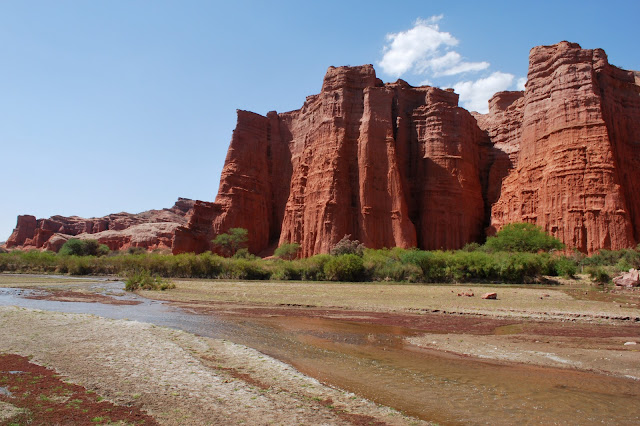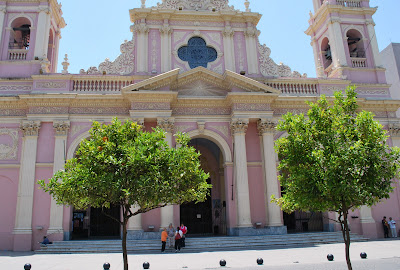Reflecting upon our time in Bolivia, some of our favourite things were the unbelievable landscapes, the traditionally dressed women, how inexpensive everything was, the local culinary specialities (saltenas, sonsos, humitas and tamales, quinoa soup, grilled alpaca), the traditional culture, being the only white people on the buses (and feeling like we were really travelling), and how cities seemed to thrive in places which really shouldn't support life (i.e. middle of the desert or 4000 meters above sea level). Things we won't miss? The buses, the lack of WIFI internet and the disinterested attempt at directions that we'd get when we asked locals.
We excitedly took our LAST night bus in Bolvia from Potosi to Villazon, a town on the border between Bolivia and Argentina. As Bolivian night buses go, it was terrible. We slept almost nothing, and were seated in the back row, so the seats didn't recline at all, and every bump was exagerated. We literally got bumped out of our seats on more than one occasion. We never put out daypacks up on the luggage racks for safety reasons (anyone will tell you this is asking for them to get snatched), but for sake of a bit of leg room, we put our bag of food up there, and at one point during the night it flew to the front of the bus. Luckily, it was later found. We would have been very sad to lose our coveted box of multi-grain cheerios (our only break from white-bread breakfasts) which we'd been packing around since Tarija. From Villazon we had to walk a couple kilometers across the border to the bus station in La Quiaca. Unfortunately, the other strap on Lisa's pack broke at this point (the first one being wired onto the pack and duct-taped already). We caught another bus from La Quiaca to Salta, and were told it was direct, but we had a layover and bus-change in San Salvador de Jujuy. We thought we had a few hours to kill, so we wandered off to a cafe for some lunch, but then noticed that the clock said it was an hour later than we thought it was... oops... time change! We rushed back to the station only to find out that our bus was an hour later than the guy originally told us. We had crackers and juice for lunch instead. We got into Salta around 6, nearly 22 hours after leaving Potosi, and checked into Hostel Backpackers Salta; a cute joint with swimming pool and bar. Our $8US-a-night hostel even came with free dinner... empanadas! The only catch was that dinner was served on Argentinian time... meaning 10:30pm. Alex had a nasty migrane and went to bed, while Dewey and Lisa went on a mission for food to tide us over and ended up with "Super Ponchos" and Argentinian Gelato (nothing else was open at this time). For those who are wondering, a Super Poncho is an ubiquitous Argentinian specialty which is basically a huge hotdog, topped with corn niblets, spicy salsa and tiny potato chips resembling hickory sticks. You could also load it up with mayo, mustard and ketchup if you desired (we didn't). Argentinians know how to do Gelato! It's unreal. [we might have had gelato every day while we were in Salta... the boys in the store laughed at us].
As soon as we crossed the border into Argentina the people and the atmosphere changed dramatically (but not the landscape). People here are SO friendly and outgoing, and genuinely seem to like tourists (you can't say this about your average Bolivian). Hostels have kitchens again, and good steak is abundant and cheap. The fashion and the architecture is extremely European, and everything is a little bit cleaner. Poverty isn't as noticeable and prices on just about everything are at least double what they were in Bolivia. The whistling and cat-calls on the street have returned, after a much-enjoyed break from them while we were in Bolivia. The elevation has dropped significantly (back down to ~1500M) and with it, the temperatures have risen dramatically (our second day in Salta was well above 30 degrees).

We switched from eating out every meal, to cooking most of our meals. In Ecuador, Peru and Bolivia, eating out was SO inexpensive, and hostel kitchens so rare, that it only made sense to eat out. You couldn't save much money by self-catering. In Argentina however, the markets and grocery stores are wonderful, and every hostel has a kitchen. As well, eating out (while still cheap in comparison to Canada) is less afordable. We've been enjoying fresh stir-frys, vegetables from the market, whole-wheat bread and pasta, humitas and tamales, and grilled steak. We've also enjoyed being able to make oatmeal for breakfast instead of the usual white bread, butter, jam and dulce de leche (a sweet caramel concoction).
Even though we spent 3 days in Salta, we have very little photo evidence of our time there. We spent much of the second day recovering from our travels, doing laundry by hand (and drying it in the hot sun), and hanging out by the pool. The next day we hiked the 1100 steps up to El Mirador, a viewpoint of the city. We enjoyed getting humitas and tamales for breakfast at the central market every morning (to get our fix before these regional specialties are gone), and gelato at "tea-time" (6:00pm). We cooked lovely meals from Argentinian ingredients that we picked up from the market, and went out on the town one night.
On the 31st, we took a bus to Cafayate (population = 12,000), a small wine region in Argentina. Halloween isn't very prevalent here, but we saw a couple little kids dressed up and doing door-to-door.
On the morning of November the 1st, we enjoyed a free wine-tour given by our hostel to two local wineries (including fresh goat cheese - Queso de Cabra). The cheese was much appreciated since cheese has been rather bland, flavorless and rubbery for the first two months of our trip. We visited La Vasija Secreta winery and Bodega Domingo Hermanos. At both wineries we tried Torrontes. Suprisingly, both tasted quite different; the first was very dry, and the second a bit sweeter. We enjoyed the Domingo version better, and think we will keep sampling Torrontes to find our favorite. At Vasija we also tried a Malbec (which was OK) and at Domingo a Tannat (which we both disliked).
 |
| Bodega Vasija Secreta |
 |
| Our photo-wine-rating system (we´ve since decided to switch to a ¨5 fingers¨ system to be more descriptive) |
That afternoon we went on a tour of the nearby 80km-long canyon Quebrada de Cafayate (a.k.a. Quebrada de las Conchas) in the Calchaquí Valley. We visited famous formations such as El Obelisco, Los Castillos (the castles), La Garganta del Diablo (the throat of the devil), El Anfiteatro (the ampitheater), el Sapo (the frog), and the mountain of 17 colors. We saw 48 kilometers of the spectacular sceenery, stopped along the way to hike around in the landscape. We took lots of pictures!
This rock formation is supposed to look like a train. Can you see it?
 |
| Los Castillos and el Rio Colorada |
The 5 distinct colours in the rock are due to oxidation of copper (blue), sulphur (yellow), zinc (brown), iron (red), and cobalt (green).
The acoustics in El Anfiteatro were fabulous. Apparently some famous Orchestra played in here once. If you look closely, you can see Alexandra standing at the bottom (to give you a sense of scale). It was an enormous hole (for which a wide angle or fish-eye lens would have done more justice)!
Below is a picture facing the other way from El Anfiteatro.
This is the Garganta del Diablo. We scaled up the flattish wall you can see behind the tree in the center to get the illusion photos below.
From Cafayate we took a short bus to Tafi del Valle, where we are now! Look, we are all caught up on the blog!! Whooo.
















Love the wine rating system! Let me know if you find a Carminere or a Malbec that you really like. I think you will appreciate a bit of civilization for a while after all your previous adventures. No more going into holes in the ground!! Love MOM
ReplyDeleteYou are constantly defying gravity!
ReplyDelete-Catherine